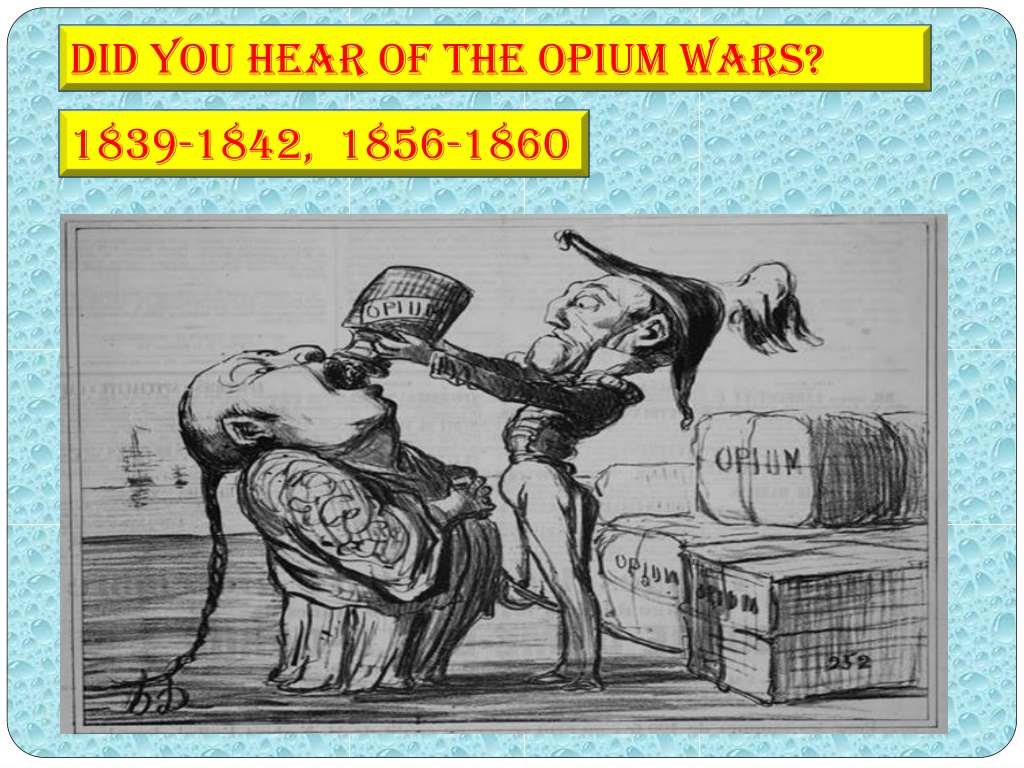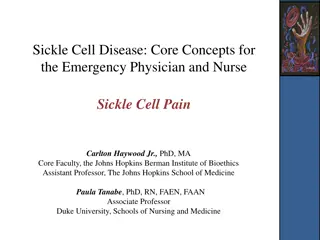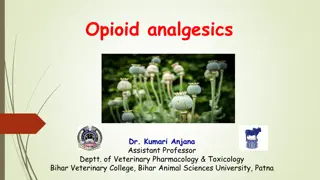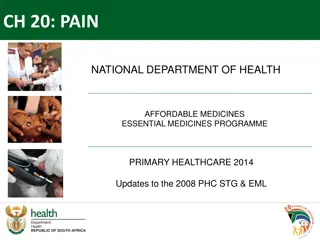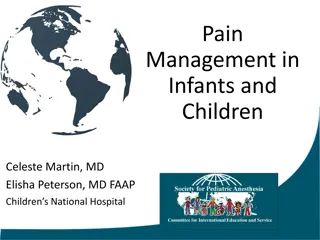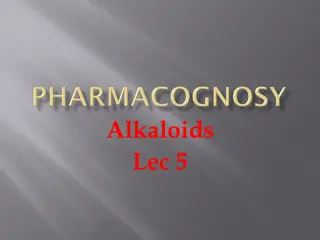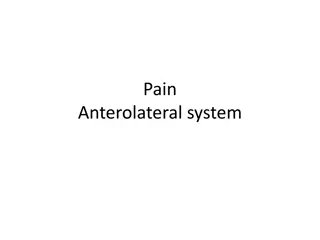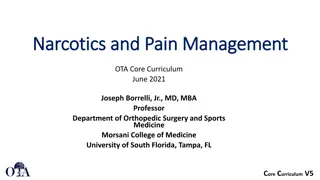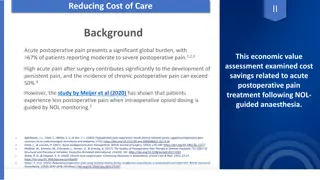The Impact of the Opium Wars and Pain Management Drugs
The Opium Wars were pivotal conflicts between China and Britain due to opium trade. Learn about the devastating effects of opium addiction on China's population. Explore the classes of drugs used in pain management, including NSAIDs and adjuvant drugs, to understand the importance of treating pain and their mechanisms of action.
Download Presentation

Please find below an Image/Link to download the presentation.
The content on the website is provided AS IS for your information and personal use only. It may not be sold, licensed, or shared on other websites without obtaining consent from the author. Download presentation by click this link. If you encounter any issues during the download, it is possible that the publisher has removed the file from their server.
E N D
Presentation Transcript
Did you hear of The opium wars? 1839-1842, 1856-1860
China was self- satisfied, traded on tea, silver & silk The balance of trade was in favor of China Britain smuggled opium from India into the territory of China the opium war
By 1835 as many as 12 million Chinese were addicted to smoking opium the opium war the opium war the opium war
Drugs Used In Management Of Pain ilos Categorize the different classes of drugs used to relieve pain Detail on the mechanism of action, pharmacokinetics and pharmacodynamic effects of morphine and its synthetic derivatives Hints on the properties and clinical uses of morphine antagonists
Drugs Used In Management Of Pain Why should we treat pain? Pain is a miserable experience What is pain? Pain is the most common reason patient seek medical advice Impairs the patient functional ability & psychological well being Pain increases sympathetic output -Increases myocardial oxygen demand -Increases BP, HR Pain limits mobility -Increases risk for DVT/PE
Drugs Used In Management Of Pain Classes of Drugs Used In Management Of Pain http://www.spinesportshc.com/wp-content/uploads/2014/06/neuropathyfeet.jpg Side-ffects NSAIDs WHO Pain Ladder Opioids Analgesia Adjuvant drugs
NSAIDS Generally the first class of drugs used for controlling pain Work at site of tissue injury to prevent the formation of the nociceptive mediators Can decrease opioid use by ~30% therefore decreasing opioid-related side effects They neither cause tolerance or dependence Has a ceilling effect to analgesia
Adjuvant drugs Adjuvant drugs Drugs primarily indicated for clinical conditions other than pain e.g. Anxiolytics, Neuroleptics, Antidepressants, Antiepileptics May modify the perception of pain May remove the concomitants of pain such as anxiety, fear, depression Useful in neuropathic pain
Opioids http://images.google.com/images?q=tbn:Lj6SQW6XHdzONM::https://amsu-health-6r.wikispaces.com/file/view/opium.jpg/33529899/opium.jpg Opium is derived from the juice of the opium poppy, Papaver somniferum The natural products include morphine, codeine,papaverine and thebaine Opiatesare drugs derived from opium and semisynthetic and synthetic derivatives Opioids refer to opiates and endogenous opioid peptides, e.g. endorphin
OPIOID RECEPTORS OPIOID RECEPTORS k ORL-1 Nociceptin receptor Antagonizes dopamine transport All of them are typical G-protein coupled receptors
CLASSIFICATION OF OPOIDs CLASSIFICATION OF OPOIDs According to their source Natural According to agonistic/antagonistic actions Heroin Morphine Semisynthetic Agonists; Morphine, Codeine, Pethidine, Methadone action on receptors According to their specificity of Pethidine, Methadone Synthetic Morphine,codeine, heroin -receptor agonists Mixed agonists /antagonists; Pentazocine, Pure antagonist; Nalaxone, Naltraxone, Pentazocine agonist at k -receptors
Mechanism of action Mechanism of action Binding to presynaptic opioid receptors coupled to Gi AC & cAMP voltage-gated Ca2+ channels excitatory transmitter. Binding to postsynaptic receptors opening of K channels neuronal excitability
Pharmacodynamic Pharmacodynamic Actions Actions Analgesia [in acute & chronic pain] Euphoria Respiratory depression Depression of cough reflexes Nausea & vomiting CRTZ Pin point pupil Releases histamine from mast cells Effects on GIT:- in tone motility severe constipation. Contraction of gall bladder +constriction of biliary sphincter pressure in the biliary tract
http://images.wisegeek.com/close-view-of-goosebumps.jpg TOLERANCE & DEPENDENCE TOLERANCE & DEPENDENCE TOLERANCE TOLERANCE Tolerance occurs rapidly with opioids (with morphine 12 24 hours) DEPENDENCE DEPENDENCE Physical dependence Withdrawal manifestations develops upon stoppage. depression, analgesia, euphoria and sedation Tolerance develops to respiratory Lasting for a few days(8-10 days) in form of body ache, insomnia, diarrhea, goose flesh, lacrimation Psychological dependence lasting for months / years craving
Pharmacokinetics Pharmacokinetics t is 2-3h It is slowly & erratically absorbed orally (bioavailability 20-40%). -Medically given by SC, IM or IV injection. Metabolized by conjugation with glucuronic acid Undergoes enterohepatic recycling, -crosses BBB -crosses placenta.
Clinical Indications Clinical Indications CONTROL PAIN; cancer pain, severe burns, trauma Severe visceral pain (not renal/biliary colic, acute pancreatitis ) Acute pulmonary edema Myocardial infarction Non painful conditions e.g. heart failure (to relieve distress) Preanesthetic medication
adrs constipation C r I n c s Respiratory depression itching Nausia,vomiting Constricted pupil sedation
Contrindications Contrindications HEAD INJURY BRONCHIAL ASTHMA or impaired pulmonary function Biliary colic Elderly are more sensitive; metabolism, lean body mass & renal function With MAOIs Not given infants, neonates or during child birth conjugating capacity accumulate respiratory
codeine Agonist Dependence < morphine Used in mild & moderate pain, cough, diarrhea
TRAMADOL TRAMADOL Synthetic, agonist , less potent Indications than morphine Inhibits also NE & 5HT reuptake ADRs -Mild - moderate acute & chronic Can be given orally; more oral bioavailability Nausea , Dry mouth, Dizziness , Sedation -Less adverse effects on respiratory & C.V.S -Seizures (not in epileptics), visceral pain -During labor
Pethidine Pethidine [ [meperidine meperidine] ] Synthetic more effective agonist actions Less analgesic, constipating , depressant on faetal respiration than morphine As in morphine but not in cough & diarrhea No cough suppressant effect Tremors, Convulsions, Hyperthermia, Hypotension Preanaesthetic medication ( better) Blurred vision, Dry mouth, Urine retention indications adrs Has atropine like action (Smooth muscle relaxant) Tolerance & Addiction Used in severe visceral pain; renal & biliary colics (sm. relaxant) Used in obstetric analgesia (No resp.)
Fentanyl Fentanyl Synthetic, agonist, more potent than pethidine & morphine Clinical uses http://images.nationalgeographic.com/wpf/media-live/photos/000/004/cache/asian-lion-sleeping_452_600x450.jpg ADRS Analgesic supplement during anesthesia, (IV or intrathecal) Respiratory depression (most serious) To induce & maintain anesthesia in poor-risk patients [stabilizing heart.] CV effects are less. Bradycardia may still occur In combination with droperidol as NEUROLEPTANALGESIA In cancer pain & severe postoperative pain; (transdermal patch changed every 72 hrs).
METHADONE METHADONE Used to treat opioid withdrawal Weaker synthetic - agonist In non addicts, it causes tolerance & dependence but not as severe as that of morphine Suboxone Mechanism of Action t 55 h An ADDICT
Opioid antagonists Nalorphine Nalorphine Naloxone Naloxone Morphine Morphine
Naloxone Naloxone Pure opioid antagonist Used to treat respiratory depression caused by opioid overdose To reverse the effect of analgesia on the respiration of the new born baby Effect lasts only for 2-4 hours Precipitates withdrawal syndrome in addicts Naltrexone Naltrexone Very similar to naloxone but with longer duration of action [t =10h]
